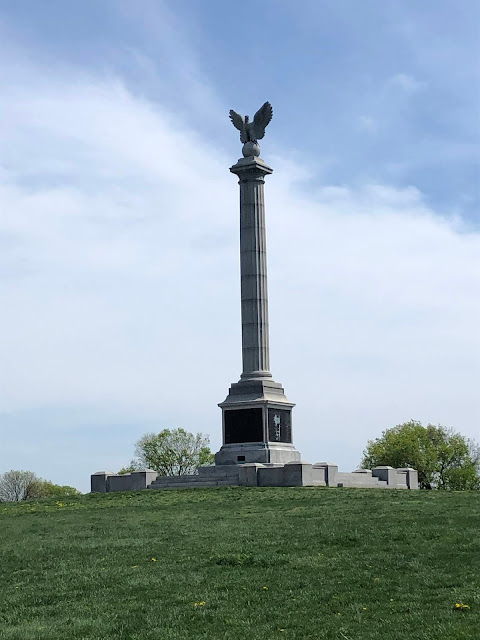Hi Everyone,
My human parents and I left Rochester on Monday, April 19th at about 1PM and drove 300+ miles to Carlile Pennsylvania where we spent the night. When we left Rochester the temperature was in the 40's. When we reached southern Pennsylvania it was 20 degrees warmer.
The next morning we drove on to Maryland where we stopped so Dad could visit the Civil War Battlefield at Antietam, near Sharpsburg, Maryland.

The battle occurred because General Robert E. Lee brought his Confederate Army of Northern Virginia across the Potomac River into Maryland intending to march to Harrisburg, the capital of Pennsylvania, and capture it. His hope was that if he could capture a northern capital city, the northern states would sue for peace, end the war and divide the nation into two countries. The Union Army, directed by General George B. McClellan, was tasked with stopping him. The two great armies (combined over 100,000 men) met near the sleepy little town of Sharpsburg, Maryland for a titanic struggle.
The battle of Antietam is significant because it was the first major battle in the eastern theater of the war in which the Union Army won a decisive victory. It also produced the highest number of casualties in a single day's fighting, of the entire four-year conflict. Nearly 23,000 men laid down their lives that warm September day in 1862, fighting for what they believed in (more than were lost in the D-Day invasion in World War II).
President Abraham Lincoln wanted to keep Great Britain and France from pressuring him to end the war and sue for peace, and he knew that using the slavery issue would accomplish that goal. He had written the Emancipation Proclamation freeing the slaves in all states fighting the Union Army earlier in the war but had hesitated to sign it and publish it until a major Union Army victory could be attained, for fear that it would seem like he were desperate.
Mom and I took a nice walk, while Dad explored all of the major points of interest on the battlefield. He in particular sought out the places where men from Rochester and the Genesee Valley fought and died during the battle.
He found the spot where the 104th New York regiment (from Geneseo and Livingston County) and 105th New York Regiment (from Rochester and Monroe County) fought in the first phase of the battle in what is now known as "the Cornfield". Any Civil War enthusiast will tell you that "the Cornfield" saw some of the most intense and deadly fighting of the entire war, with some regiments losing as many as 60% of their men in mere minutes.
Another interesting place on the battlefield was a sunken road near the center of the Confederate Army's lines where Southern soldiers held off repeated attacks by Union soldiers for hours. As in the Cornfield, there was bitter, heavy fighting here, sometimes hand to hand, as desperate men exhausted their ammunition and resorted to bayonets, hunting knives, and ever bludgeoned each other to death with rocks.
This place has been dubbed "Bloody Lane" by historians since the Confederate dead were piled three deep and the road was drenched with their blood after the famous Irish Brigade from New York finally overran their position forcing them to flee.
The final phase of the battle took place at a small bridge (which has been reconstructed) at the far right of the Confederate battle lines. The bridge is now known as "Burnside's Bridge" named after the Union general who was tasked with storming it with the 9th Corps of the Union Army.
A small unit (less than 1,000 men) of very brave soldiers from the State of Georgia held the high ground on one side of Antietam Creek and prevented Burnside's troops (nearly 10,000 men) from crossing the bridge and flanking the entire Confederate Army and possibly ending the war.
Finally, after holding their position against overwhelming odds for the entire morning, running low on ammunition, and having been flanked by Union troops who forded the creek upstream and attacked them from behind, they abandoned their position around 1 PM.
The battle came to a halt soon after when fresh Confederate troops under General Jackson, arrived from Harper's Ferry to counter the Union assault. The battle at Antietam was over. Due to the intense fighting by both sides, it became the costliest single day in human lives of the entire war.
This is a beautiful and peaceful place now. It is sad that this nice place had to endure such a horrific battle and such a terrible loss of life on that day in 1862. This battle marked the beginning of the end of slavery in America.
Tomorrow we are going to Shenandoah National Park in Virginia😊.








Hi Kohdie! Hi Dad and Mom!
ReplyDeleteAre those pink lilacs? Their so pretty!
No, those are close-ups of Red Bud Trees in bloom.
DeleteDad and Kohdie,
ReplyDeleteThank you for the history lesson on the battle at Antietam. Your narration made me feel as though I was there watching.
Are you sure we weren't there? The pictures you posted look very familiar to me.
They are very much like the things we saw at Gettysburg when we there.
Delete